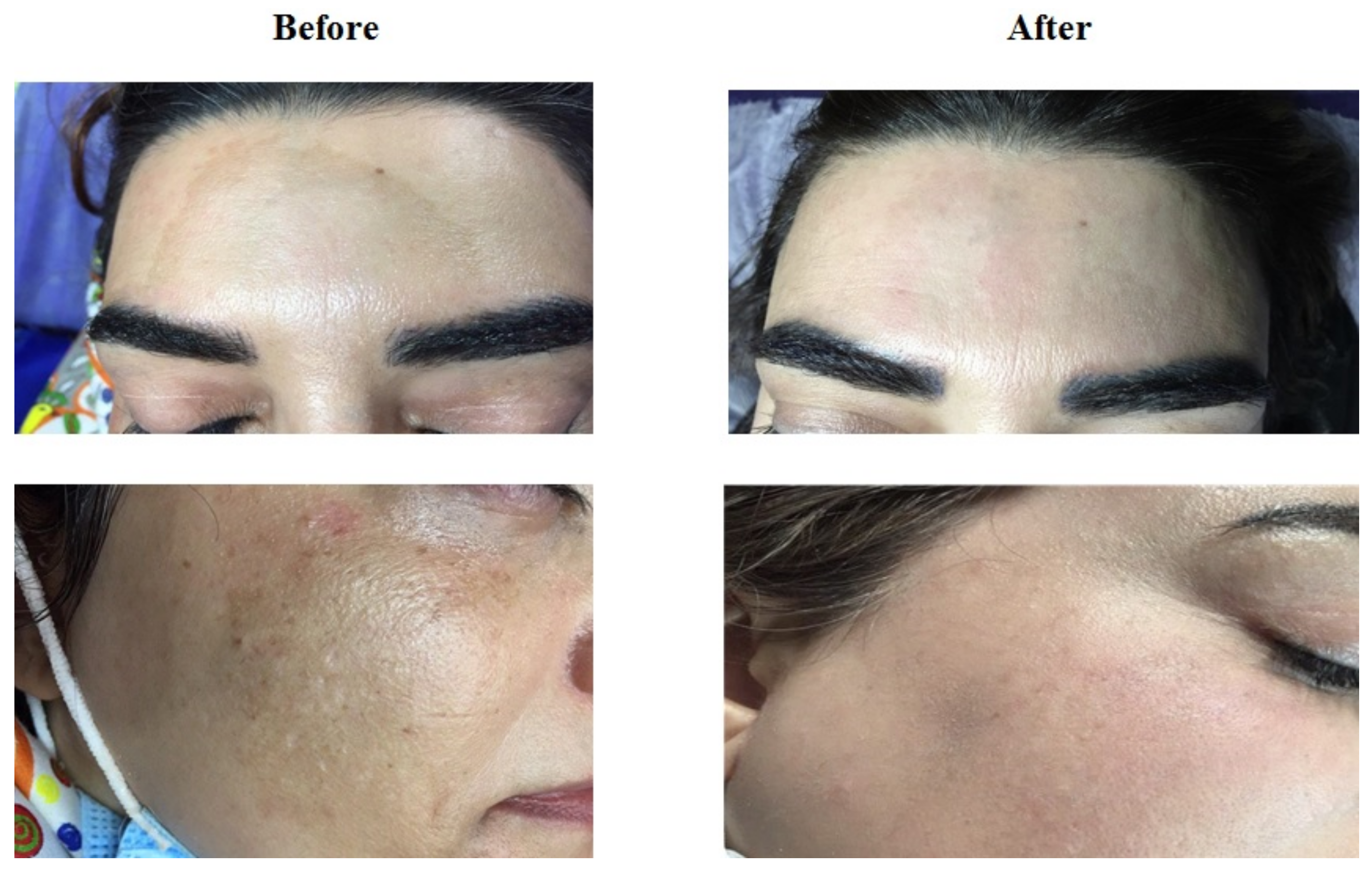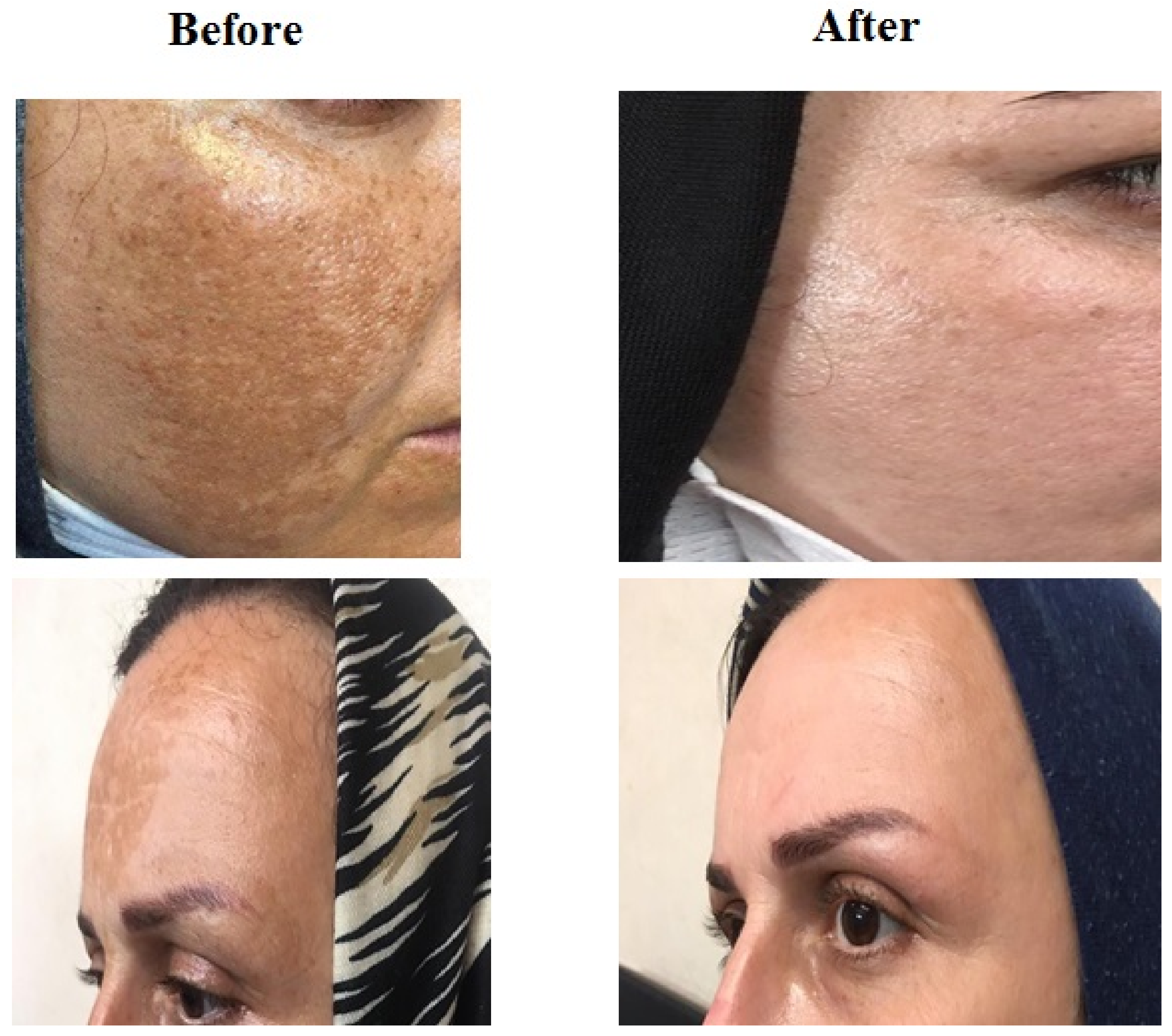Comparative Efficacy of Fractional CO2 Laser and Q-Switched Nd:YAG Laser in Combination Therapy with Tranexamic Acid in Refractory Melasma: Results of a Prospective Clinical Trial
Abstract
1. Introduction
2. Materials and Methods
3. Results
4. Discussion
5. Conclusions
Author Contributions
Funding
Institutional Review Board Statement
Informed Consent Statement
Data Availability Statement
Conflicts of Interest
References
- Sarkar, R.; Arora, P.; Garg, V.K.; Sonthalia, S.; Gokhale, N. Melasma update. Indian Dermatol. Online J. 2014, 5, 426. [Google Scholar] [PubMed]
- Ball Arefiev, K.L.; Hantash, B.M. Advances in the treatment of melasma: A review of the recent literature. Dermatol. Surg. 2012, 38 Pt 1, 971–984. [Google Scholar] [CrossRef] [PubMed]
- Hsiao, C.Y.; Sung, H.C.; Hu, S.; Huang, C.H. Fractional CO2 laser treatment to enhance skin permeation of tranexamic acid with minimal skin disruption. Dermatology 2015, 230, 269–275. [Google Scholar] [CrossRef] [PubMed]
- Jalaly, N.Y.; Valizadeh, N.; Barikbin, B.; Yousefi, M. Low-power fractional CO2 laser versus low-fluence Q-switch 1064 nm Nd:YAG laser for treatment of melasma: A randomized, controlled, split-face study. Am. J. Clin. Dermatol. 2014, 15, 357–363. [Google Scholar] [CrossRef]
- Kwon, H.H.; Choi, S.C.; Jung, J.Y.; Park, G.H. Combined treatment of melasma involving low-fluence Q-switched Nd: YAG laser and fractional microneedling radiofrequency. J. Dermatol. Treat. 2019, 30, 352–356. [Google Scholar] [CrossRef]
- Moin, A.; Jabery, Z.; Fallah, N. Prevalence and awareness of melasma during pregnancy. Int. J. Dertmatol. 2006, 45, 285–288. [Google Scholar] [CrossRef]
- Ortonne, J.; Arellano, I.; Berneburg, M.; Cestari, T.; Chan, H.; Grimes, P.; Hexsel, D.; Im, S.; Lim, J.; Lui, H.; et al. A global survey of the role of ultraviolet radiation and hormonal influences in the development of melasma. J. Eur. Acad. Dermatol. Venereol. 2009, 23, 1254. [Google Scholar] [CrossRef]
- Arora, P.; Sarkar, R.; Garg, V.; Arya, L. Lasers for treatment of melisma and post-inflammatory hyperpigmentation. J. Cutan. Aesthet. Surg. 2012, 5, 93–103. [Google Scholar]
- Wang, C.C.; Hui, C.Y.; Sue, Y.M.; Wong, W.R.; Hong, H.S. Intense pulsed light for the treatment of refractory melasma in Asian persons. Dermatol. Surg. 2004, 30, 1196–1200. [Google Scholar]
- Angsuwarangsee, S.; Polnikorn, N. Combined ultrapulse CO2 laser and Q-switched alexandrite laser compared with Q-switched alexandrite laser alone for refractory melasma: Split-face design. Dermatol. Surg. 2003, 29, 59–64. [Google Scholar] [CrossRef]
- Manaloto, R.M.P.; Alster, T. Erbium: YAG laser resurfacing for refractory melasma. Dermatol. Surg. 1999, 25, 121–123. [Google Scholar] [CrossRef][Green Version]
- Rodrigues, M.; Pandya, A.G. Melasma: Clinical diagnosis and management options. Australas. J. Dermatol. 2015, 56, 151–163. [Google Scholar] [CrossRef]
- Torok, H.M.; Jones, T.; Rich, P.; Smith, S.; Tschen, E. Hydroquinone 4%, tretinoin 0.05%, fluocinolone acetonide 0.01%: A safe and efficacious 12-month treatment for melasma. Cutis 2005, 75, 57–62. [Google Scholar]
- Cetari, T.F.; Hassun, K.; Sittart, A.; De Lourdes Viegas, M. A comparison of triple combination cream and hydroquinone 4% cream for the treatment of moderate to severe facial melasma. J. Cosmet. Dermatol. 2007, 6, 36–39. [Google Scholar]
- Shin, J.U.; Park, J.; Oh, S.H.; Lee, J.H. Oral tranexamic acid enhances the efficacy of low fluence 1064 Nm quality-switched neodymium doped yttrium aluminum garnet laser treatment for melasma in Koreans: A randomized, prospective trial. Dermatol. Surg. 2013, 39, 435–442. [Google Scholar] [CrossRef]
- Kim, E.H.; Kim, Y.C.; Lee, E.S.; Kang, H.Y. The vascular characteristics of melasma. J. Dermatol. Sci. 2007, 46, 111–116. [Google Scholar] [CrossRef]
- Nistico, S.; Tlolone, M.; Zingoni, T.; Tamburi, F.; Scali, E.; Bennardo, L.; Cannarozzo, G. Photobiomodulation. Photomed. Laser Surg. 2020, 38, 560–564. [Google Scholar]
- Duca, E.D.; Zingoni, T.; Bennardo, L.; Raimondo, C.D.; Garofalo, V.; Sannino, M.; Petrini, N.; Cannarozzo, G.; Bianchi, L.; Nistico, S.P. Photobiomodulation. Photomed. Laser Surg. 2021, 39, 137–140. [Google Scholar]
- Cannarozzo, G.; Negosanti, F.; Sannino, M.; Santoli, M.; Bennardo, L.; Banzola, N.; Negosanti, L.; Nistico, S.P. Q-switched Nd:YAG laser for cosmetic tattoo removal. Dermatol. Ther. 2019, 32, e13042. [Google Scholar] [CrossRef]
- Tawfic, S.O.; Abdel Halim, D.M.; Albarbary, A.; Abdelhady, M. Assessment of combined fractional CO2 and tranexamic acid in melasma treatment. Lasers Surg. Med. 2019, 51, 27–33. [Google Scholar] [CrossRef]
- Suh, K.S.; Sung, J.Y.; Roh, H.J.; Jeon, Y.S.; Kim, Y.C.; Kim, S.T. Efficacy of the 1064-nm Q-switched Nd: YAG laser in melasma. J. Dermatolog. Treat. 2011, 22, 233–238. [Google Scholar] [CrossRef] [PubMed]
- Kauvar, A.N. Successful treatment of melasma using a combination of microdermabrasion and Q-switched Nd: YAG lasers. Lasers Surg. Med. 2012, 44, 117–124. [Google Scholar] [CrossRef] [PubMed]
- Cho, S.; Kim, J.; Kim, M. Melasma treatment in Korean women using a 1064 nm Q-switched Nd: YAG laser with low pulse energy. Clin. Exp. Dermatol. 2009, 34, e847–e850. [Google Scholar] [CrossRef] [PubMed]
- Sim, J.H.; Park, Y.L.; Lee, J.S.; Lee, S.Y.; Choi, W.B.; Kim, H.J.; Lee, J.H. Treatment of melasma by low-fluence 1064 nmQ-switched Nd:YAG laser. J. Dermatol. Treat. 2014, 25, 212–217. [Google Scholar] [CrossRef]
- Abadchi, S.N.; Naeini, F.F.; Beheshtian, E. Combination of hydroquinone and fractional CO2 laser versus hydroquinone monotherapy in melasma treatment: A randomized, single-blinded, split-face clinical trial. Indian J. Dermatol. 2019, 64, 129. [Google Scholar]


| Q-Switched Nd:YAG Laser | Fractional CO2 Laser | ||||
|---|---|---|---|---|---|
| Mean | Standard Deviation | Mean | Standard Deviation | p-Value | |
| PtGA-Baseline | 3.70 | 0.70 | 3.63 | 0.93 | 0.755 |
| PtGA-4 | 3.73 | 0.78 | 2.87 | 0.68 | 0.000 |
| PtGA-8 | 3.13 | 0.82 | 2.37 | 0.61 | 0.000 |
| PtGA-12 | 2.47 | 0.68 | 1.93 | 0.78 | 0.007 |
| p-value | 0.000 | 0.000 | |||
| PtS-4 | 3.83 | 0.91 | 3.67 | 0.76 | 0.445 |
| PtS-8 | 3.13 | 0.86 | 2.80 | 0.76 | 0.117 |
| PtS-12 | 2.53 | 1.04 | 2.07 | 0.91 | 0.069 |
| p-value | 0.000 | 0.000 | |||
| Q-Switched Nd:YAG Laser | Fractional CO2 Laser | ||||
|---|---|---|---|---|---|
| Mean | Standard Deviation | Mean | Standard Deviation | p-Value | |
| PGA-B | 3.53 | 0.94 | 3.47 | 0.90 | 0.780 |
| PGA-4 | 3.30 | 0.75 | 2.90 | 0.92 | 0.071 |
| PGA-8 | 2.73 | 0.64 | 2.33 | 0.66 | 0.021 |
| PGA-12 | 2.43 | 0.73 | 2.00 | 0.74 | 0.026 |
| p-value | 0.000 | 0.000 | |||
| PS-4 | 3.83 | 0.53 | 3.60 | 0.62 | 0.123 |
| PS-8 | 3.23 | 0.63 | 2.80 | 0.76 | 0.019 |
| PS-12 | 2.50 | 0.78 | 2.17 | 1.09 | 0.177 |
| p-value | 0.000 | 0.000 | |||
| Q-Switched Nd:YAG Laser | Fractional CO2 Laser | ||||
|---|---|---|---|---|---|
| Mean | Standard Deviation | Mean | Standard Deviation | p-Value | |
| MASI-B | 5.14 | 2.76 | 4.89 | 2.05 | 0.702 |
| MASI-4 | 4.46 | 2.69 | 3.45 | 2.36 | 0.129 |
| MASI-8 | 4.25 | 2.49 | 2.12 | 1.76 | 0.000 |
| MASI-12 | 2.52 | 2.45 | 1.84 | 1.91 | 0.237 |
| p-value | 0.000 | 0.000 | |||
Publisher’s Note: MDPI stays neutral with regard to jurisdictional claims in published maps and institutional affiliations. |
© 2021 by the authors. Licensee MDPI, Basel, Switzerland. This article is an open access article distributed under the terms and conditions of the Creative Commons Attribution (CC BY) license (https://creativecommons.org/licenses/by/4.0/).
Share and Cite
Beyzaee, A.M.; Patil, A.; Goldust, M.; Moslemi, M.; Kazeminejad, A.; Rokni, G.R. Comparative Efficacy of Fractional CO2 Laser and Q-Switched Nd:YAG Laser in Combination Therapy with Tranexamic Acid in Refractory Melasma: Results of a Prospective Clinical Trial. Cosmetics 2021, 8, 37. https://doi.org/10.3390/cosmetics8020037
Beyzaee AM, Patil A, Goldust M, Moslemi M, Kazeminejad A, Rokni GR. Comparative Efficacy of Fractional CO2 Laser and Q-Switched Nd:YAG Laser in Combination Therapy with Tranexamic Acid in Refractory Melasma: Results of a Prospective Clinical Trial. Cosmetics. 2021; 8(2):37. https://doi.org/10.3390/cosmetics8020037
Chicago/Turabian StyleBeyzaee, Amir Mohammad, Anant Patil, Mohamad Goldust, Marjan Moslemi, Armaghan Kazeminejad, and Ghasem Rahmatpour Rokni. 2021. "Comparative Efficacy of Fractional CO2 Laser and Q-Switched Nd:YAG Laser in Combination Therapy with Tranexamic Acid in Refractory Melasma: Results of a Prospective Clinical Trial" Cosmetics 8, no. 2: 37. https://doi.org/10.3390/cosmetics8020037
APA StyleBeyzaee, A. M., Patil, A., Goldust, M., Moslemi, M., Kazeminejad, A., & Rokni, G. R. (2021). Comparative Efficacy of Fractional CO2 Laser and Q-Switched Nd:YAG Laser in Combination Therapy with Tranexamic Acid in Refractory Melasma: Results of a Prospective Clinical Trial. Cosmetics, 8(2), 37. https://doi.org/10.3390/cosmetics8020037







